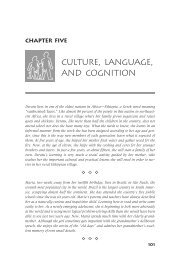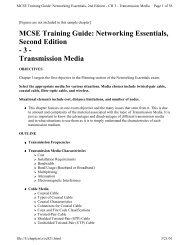SOCIAL PROBLEMS: A Down-to-Earth Approach, 8/e
SOCIAL PROBLEMS: A Down-to-Earth Approach, 8/e
SOCIAL PROBLEMS: A Down-to-Earth Approach, 8/e
You also want an ePaper? Increase the reach of your titles
YUMPU automatically turns print PDFs into web optimized ePapers that Google loves.
ay you be the mother of a<br />
“Mhundred sons” is the <strong>to</strong>ast<br />
made <strong>to</strong> brides in India, where<br />
the birth of a son brings shouts<br />
of rejoicing, but the birth of a<br />
daughter brings tears of sadness.<br />
Why? A son continues the<br />
family name, preserves wealth and property<br />
within the family, takes care of aged parents<br />
(the elderly have no Social Security), and performs<br />
the parents’ funeral rites. Hinduism<br />
even teaches that a sonless man cannot<br />
achieve salvation.<br />
A daughter, in contrast, is a liability. Men<br />
want <strong>to</strong> marry only virgins, and the parents<br />
of a daughter bear the burden of having <strong>to</strong> be<br />
constantly on guard <strong>to</strong> protect her virginity.<br />
For their daughter <strong>to</strong> marry, the parents must<br />
also pay a dowry <strong>to</strong> her husband. A common<br />
saying in India reflects the female’s low status:<br />
“To bring up a daughter is like watering<br />
a neighbor’s plant.”<br />
This cultural context sets the stage for female infanticide,<br />
killing newborn girl babies, a practice that has been common<br />
in India for thousands of years. Using diagnostic techniques<br />
(amniocentesis and ultrasound) <strong>to</strong> reveal the sex of the fetus,<br />
many Indians have replaced female infanticide with gender-selective<br />
abortion. If prenatal tests reveal that the fetus is female,<br />
they abort it. Some clinics even put up billboards that proclaim,<br />
“Invest Rs.500 now, save Rs.50,000 later.” This means that by<br />
paying Rs.500 (500 Indian rupees) <strong>to</strong> abort a female, a family<br />
can save a future dowry of 50,000 rupees.<br />
A Global Glimpse<br />
ONLY FEMALES ELIGIBLE:<br />
SEX-SELECTION ABORTION IN INDIA<br />
away. As you know, this assumption was naive. Feelings were so strong that groups which<br />
had been hostile <strong>to</strong> one another for centuries, such as Roman Catholics and Baptists, began<br />
<strong>to</strong> work <strong>to</strong>gether <strong>to</strong> oppose abortion. Shocked at what they considered the killing of<br />
babies, they <strong>to</strong>ok <strong>to</strong> the streets and <strong>to</strong> the courts, fighting pitched battles over this issue<br />
that lies at the heart of social divisions in U.S. society.<br />
A NOTE ON TERMS. Before we go further in our analysis of abortion as a social problem,<br />
we need <strong>to</strong> pause <strong>to</strong> consider the matter of terms. Definitions and terms are always significant,<br />
but especially so when we deal with highly sensitive issues such as abortion. The<br />
terms prochoice and prolife, chosen by advocates on each side on this social problem, represent<br />
attitudes and positions which sometimes provoke strong emotional response. As<br />
you may have noticed as you read the box on the relativity of social problems, I use the<br />
terms antiabortion and proabortion. Although these terms, purposely chosen and intended<br />
<strong>to</strong> be neutral, are not entirely satisfac<strong>to</strong>ry, I shall use the term antiabortion <strong>to</strong> refer <strong>to</strong> those<br />
who oppose the legal right <strong>to</strong> abortion and proabortion <strong>to</strong> refer <strong>to</strong> those who favor this<br />
legal right. As I discuss in the Preface, neither side on the abortion issue prefers these terms.<br />
(For detailed background, see pages xviii–ix). If I have succeeded in my intentions in this<br />
chapter, even if readers do not like this choice of terms, both those who favor the legal<br />
right <strong>to</strong> abortion and those who oppose it will feel that I have presented their side fairly.<br />
Even though their husbands<br />
and other relatives urge them <strong>to</strong><br />
have an abortion, some women<br />
who are pregnant with a female<br />
fetus resist. Since these abortions<br />
are profitable, medical personnel<br />
try <strong>to</strong> sell reluctant women on the<br />
idea. To overcome their resistance, one clinic<br />
has hit on an ingenious technique: Nurses<br />
reach under the counter where they keep the<br />
preserved fetuses of twin girls. When a woman<br />
sees these bottled fetuses, the horror of double<br />
vigilance and two dowries is often sufficient<br />
<strong>to</strong> convince her <strong>to</strong> have an abortion.<br />
National newspapers headlined the events<br />
in one clinic: A male fetus had been unintentionally<br />
aborted. This sparked protests, and<br />
the Indian legislature passed a law forbidding<br />
doc<strong>to</strong>rs <strong>to</strong> tell would-be parents the sex of<br />
their fetuses. Physicians who violate the law<br />
can be sent <strong>to</strong> prison and banned from their<br />
profession.<br />
Going unenforced, however, this law has had little or no effect.<br />
An eminent physician has even stated publicly: “The need<br />
for a male child is an economic need in our society, and our feminists<br />
who are raising such hue and cry about female feticide<br />
should realize that it is better <strong>to</strong> get rid of an unwanted child<br />
than <strong>to</strong> make it suffer all its life.”<br />
What do you think? In answering this, try <strong>to</strong> put yourself in<br />
the position of Indians in poverty.<br />
Based on Kusum 1993; Holman 1994; Raghunathan 2003.<br />
WHAT IS A <strong>SOCIAL</strong> PROBLEM? 7
















